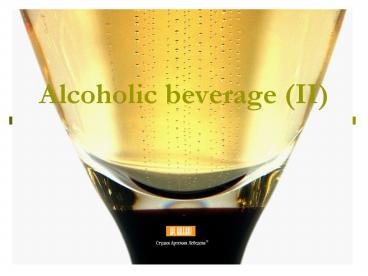Alcoholic beverage (II) - PowerPoint PPT Presentation
1 / 20
Title:
Alcoholic beverage (II)
Description:
Alcoholic beverage (II) Wine Making Sulfur Dioxide Treatment Use wine starter cultures versus spontaneous (natural) fermentation Inactivate indigenous microflora ... – PowerPoint PPT presentation
Number of Views:343
Avg rating:3.0/5.0
Title: Alcoholic beverage (II)
1
Alcoholic beverage (II)
2
Wine Making
- Sulfur Dioxide Treatment
- Use wine starter cultures versus spontaneous
(natural) fermentation - Inactivate indigenous microflora
- Minimize competition and interference
- Heat-treatment detrimental to juice and wine
- Sulfite-treated, most commonly SO2 gas or
potassium bisulfite - Inhibit wild yeast as well as acetic
acid-producing microbes, malolactic bacteria, and
various fungi - Control deleterious chemical reactions
- Oxidation and browning
3
Microbial Ecology
- Yeast primarily associated with grape surface
Kloeckera apiculata - S. cerevisiae introduced into the must durng
handling and crushing, most likely from the
equipment - Succession
- Must as selective environment
- Low pH
- Presence of organic acids
- High sugar conc and high osmotic pressure
- CO2 anaerobic, restrict growth of aerobic
organisms - Ethanol
- Sulfite
4
Microbial Ecology
- Saccharomyces less than 10 of the initial yeast
population - K. apiculata dominant
- Produce 6 ethanol from glucose and fructose
- Low ethanol tolerance, inhibited by 3-4 ethanol
5
Separation and Pressing
- Juice separated from seeds, skins, and pulp
(pomace) using screens by gravitational forces - 75 free run juice, more juice recovered by
various processes (pressed juice) - Clarification
- Settling, decantation, filtration or
centrifugation
6
Fermentation
- Limited fermentation before addition of starter
culture - Culture added to the must
- after pressing and clarification for white wine
making - Before seed and skin removal for red wine (during
maceration) - Traditional fermentation in open barrels, closed
stainless steel tanks now more common
7
Fermentation
- Temperature
- 7-20C for white wine
- 20-30C for red wine
- Low temp loss less ethanol and volatile flavors
due to evaporation - Produce more flavor compounds, ethanol and less
sugar left - Wine fermentation generates heat, too much may
affect wine fermentation (stuck) - Typically fermentation takes 3-5 days at 10-15C
- Adjustments, blending, clarification
- Aging
8
Malolactic Fermentation
- As important as the yeast fermentation to wine
quality - Acidity 3.3-3.6 for red wine, white wine slightly
more acidic - High level organic acids, excess acidity serious
flavor defect - Malic acid important to influence acidity
- Decomposition into lactic acid via malolactic
fermentation (fig 10-4) - Several LAB, particularly Oenococcus oeni
(previously Leuconostoc), some Lactobacillus
9
Types of Wine
- Sweet wines
- noble rot by Botrytis cinerea
- Dehydration of grapes
- 9-13 ethanol, as much as 10 unfermented sugar
- Fortified wines
- Added distilled spirits (containing as much as
95 ethanol) to raise ethanol conc to 15
10
Sparkling wines
- Foam readily due to the presence of high
concentration of dissolved CO2 - 4.05-5.06 Pa (4-5 atm) at 20C (general), 2.03 Pa
(2 atm) (US) - Methods of production
- Champagne process (bottle fermentation, remove by
disgorging) - Transfer profess (bottle fermentation, transfer
to a tank, and removal of the yeast by
filtration) - Bulk fermentation
- Carbonation
11
Champagne Process
Dry white wine
Sucrose 25g/l, pure culture yeast
Secondary fermentation
9-12C, closed bottle Several months
Rest for months-years
Yeast is collected and frozen in the neck of the
bottles
Disgorge
Lost volume replaced by a sucrose solution
12
Other processes
- Transfer process
- Bottle fermentation
- Yeast removed by transferring wine to a tank with
nitrogen pressure - Add dosage, filtered and bottle filled with
nitrogen or CO2 counterpressure - Bulk fermentation
- Mass production, fermentation carried in
pressured vessel - Filtration and bottling
- Carbonation
- No secondary fermentation
13
Vinegar
14
Vinegar
- Can be make from almost any fruits, grains, mash
(alcohol-containing), beer and wine - Contains at least 4 g of acetic acid per 100 ml
(20C) - pH 2-3.5
15
Chemistry
Acetic acid
Sugar
Alcohol
Acetic acid
Lactic acid
Acidic acid bacteria Acetobacter Gluconobacter, G
luconoacetobacter, Acidomonas
Lactic acid bacteria, yeasts
16
Vinegar Fermentation
- Oxidative fermentation, ethanol oxidized with air
to acetic acid and water - By Acetobacter spp.
C2H5OH O2
CH3COOH H2O
17
Varieties
- Wine vinegar
- From grape wine
- Cider vinegar
- From apple cider
- Malt vinegar
- Barley malt or cereals, with starch converted by
the malt - Rice vinegar
- Saccharification of rice starch, followed by
alcoholic and acetous fermentation - Sugar vinegar, whey vinegar, fruit vinegar, etc.
18
Nutrients and water requirements
- Usually dont need additional nutrients
- Ammonium phosphate sometimes is added to apple
cider and some grape wines - Water free from chlorine
- Additional nutrients required to make distilled
vinegar
19
Behavior of Acetobacter in vinegar fermentation
- Lack of oxygen
- Significant cell damage 10-100, depend on the
duration - Lack of ethanol
- Cause sever damage to the cells
- Changes in temperature
- Temperature circulation too quick, cause cell
damage - Over-oxidation
- Undesirable oxidation to CO2
- automation
- Growth rate, etc.
20
Conditions for vinegar fermentation
- Step 1 alcoholic fermentation
- Organism(s) involved
- Fermentation condition
- Step 2 acetification
- Organism(s) involved
- Fermentation condition































